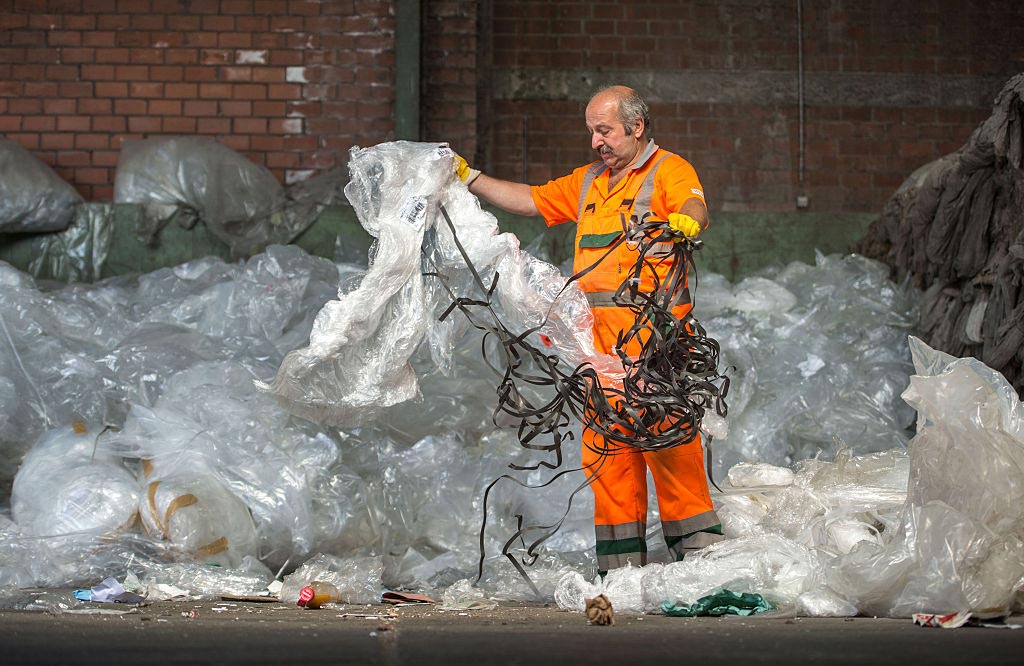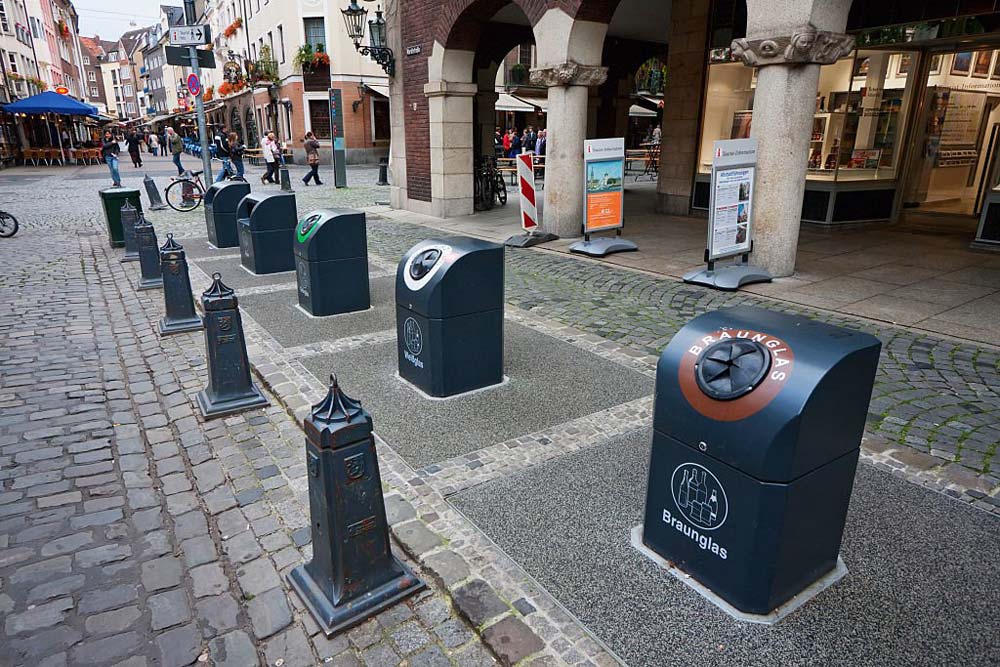世界上最擅长回收的德国人,也拿一次性塑料制品没办法

|
吉莉安·约克自认为是一个非常擅长垃圾回收的人。 毕竟,她小时住在新罕布什尔州时,就是一个非常注重资源回收的人。后来她搬到了旧金山居住。2013年,她又搬到了伯林,而这时她却面临着一个迫切的问题。 玻璃瓶应该怎么处理? 废纸和塑料处理起来是非常简单的,只需将它们收集起来,分门别类地扔进那种在德国随处可见的按颜色区分的垃圾箱即可。但这里却没有装瓶子的垃圾箱。 约克是一名言论自由活动人士。她表示:“我家里的玻璃瓶越堆越多,德国朋友来我家时都会说:‘你有麻烦了’。” 当然,解决办法也不是没有。你可以把它们拖到附近的小卖店里卖一点钱,也可以把他们留给收破烂的,然后从他们手里换钱。(然而无论采取哪种方式,都是有风险的——这也是德国举世闻名的垃圾回收政策的关键问题。) 在德国生活一段时间后,约克购买了一个家用的按颜色分类的垃圾箱,学会了如何正确地拆解包装。如果她在街上找不到明显可以回收塑料瓶的地方,就会把它们带回家处理。她已经完全被同化成了一个德国人。 “我成了他们中的一员了。”她说。 看到这里,你可能已经猜到了,德国人对待垃圾回收是极为严肃的。 德国在垃圾回收利用率上常年排名世界第一,紧随其后的是奥地利。 |
Jillian York thought she knew how to recycle. After all, she had spent a childhood diligently recycling in New Hampshire, and was living in San Francisco. But when she moved to Berlin in 2013, she faced an urgent question. Where do the glass bottles go? The paper and plastic was simple enough: collect and sort into a series of color-coded bins ubiquitous in German neighborhoods. But there was no bin for the bottles. “They were just piling up in my house,” says York, who works as a free speech activist. “German friends came over and they said, ‘you have a situation.’” The fix: lug the bottles to a nearby grocery store to exchange for a small rebate, or leave them for someone else to pick up and pocket the cash. (Either way there’s money at stake—a key to Germany’s world-renowned recycling program.) From there, York bought her own indoor, multi-colored sorting bin, learned how to properly disassemble packaging, and started carting home plastic bottles when there was nowhere obvious to recycle them on the street. Her assimilation was complete. “I’ve become one of them,” she says. Germans, as you might have guessed, take recycling extremely seriously. The country typically ranks first in the world for collection rates. Austria comes second. |

|
讽刺的是,让约克最头疼的玻璃瓶,却是德国人最不担心的——它们是最容易回收利用的物品之一。而玻璃瓶外面的塑料包装纸则是另一回事了。 全世界都非常重视塑料制品对环境造成的损害。现在越来越多的国家对塑料制品加强了监管,比如欧盟通过投票决定,到2021年前,要禁止10种一次性塑料制品。然而即便是世界上最擅长回收的德国人,也仍面临着一个挠头的问题,为什么这么多可回收利用的塑料制品,最终还是被丢进了垃圾桶? 阿喀琉斯之踵 现代化的回收利用,是随着上世纪70年代的环境保护运动兴起的。到上世纪90年代,德国制定了一部《主要包装法》。到今天,根据欧洲统计局2017年的数据,德国回收了其近68%的家庭垃圾。相比之下,英国的回收率为44%,美国仅为26%。 一些专家认为,德国的成功要归功于它的玻璃瓶处理方案,还有一些人归功于德国无所不在的垃圾分类系统。德国对于回收多少废品是有强制配额的。包装物的生产商们还要给一个叫做“绿点系统”的回收计划交钱,德国用于的垃圾回收分类的资金基本都来自这个计划。 还有一部分人的结论更加简单——因为那是“良心下水道”的德国人嘛。 德累斯顿科技大学的废物管理与循环经济学家克里斯蒂娜·多纳克表示:“对我来说,回收是融在血液里的一种本能。德国人天生就遵守规则。” 不过,就连德国人也在与废品界的“阿喀琉斯之踵”作斗争——也就是那些一次性塑料制品。 德国几乎回收了所有能回收的塑料缺品,然而对于塑料包装品的实际回收率,只有48%多一点。 “这就是我们面临的挑战。” 多纳克表示。 设计与经济学 问题是,有好几种塑料废品是很难回收利用的。英国艾伦麦克阿瑟基金会发起的“新塑料经济”运动指出,尽管这些废品也被回收了,但它们并没有再次进入经济循环,而是最终与普通垃圾一样进了填埋场。 仅举几个例子:一是非常容易掉进缝隙里的小片塑料(比如酱油包)。二是上面放了太多食物的塑料(比如快餐盒)。三是回收前要单独拆开的包装物(比如薯片的袋子)。最后是用“不常见”的塑料制作的物品——并不是说它们不能被回收利用,只是它们的数量太少,不足以形成经济规模。另外它们还会污染其它塑料制品(比如药品的吸塑包装)。 这意味着,一旦政府建立了一套可以正确分类和收集废物的系统,塑料回收就会遇到两个问题,一是设计问题,二是经济问题。(之前有一个解决方案,就是把所有垃圾运到中国去。现在这条路已经走不通了。) “新塑料经济”运动的领导者罗勃·奥普索默表示,很多包装物“都被设计成了无法回收的东西”。企业如果对设计进行投资,将塑料制品设计得易于回收,则可以在一定程度上解决这个问题。比如将塑料制品设计得更简洁,减少层次和材料的种类等等。 经济问题也包含了两个方面,一是回收系统本身是要花钱的(在美国,很多市一级的政府甚至掏不起这笔钱)。二是很多地方生产的回收材料,可能甚至超出了企业想要购买的量——这也是德国面临的一个难题。多纳克表示,很多制造商都对回收的塑料不感兴趣,因为他们认为这些塑料的质量比较差。他们还是更喜欢使用“原装”的塑料,因为他们认为这些“原装”塑料更便宜、干净和耐用。 德国正试图解决所有这些问题。解决方案是什么呢?当然是出台更多的规则。 今年1月1日生效的新《包装法》提高了回收的目标,并致力于推动减少浪费。德国致力于将塑料制品的总体回收目标从当前的60%提高到2022年的90%。该法律敦促企业在产品中使用更多的可回收材料,并设计更好的包装。 专家表示,这些措施与对一次性塑料制品的禁令是相辅相成的。减少一次性塑料制品,意味着回收系统会变得更加强大。二者起到互相促进的作用。 约克表示,尽管如此,德国还是会有不少普通的垃圾回收者伤心地意识到,自己辛辛苦苦对垃圾进行收集和分类,结果很多努力都是徒劳的。 她表示:“不要让这种事情发生,人们会很难过的。”(财富中文网) 译者:朴成奎 |
Ironically, York’s glass bottles are the least of Germany’s worries—they’re among the easiest items to recycle or reuse. The plastic packaging they often come in, however, is another matter. The world has rightfully become obsessed with plastic and the toll it takes on the environment. But as new plastic-related regulation gains traction—the European Union voted to ban 10 types of single-use plastics by 2021—there’s a question still dogging even the world’s best recycler: Why do so many recycled plastic items still end up in the trash? The Achilles Heel Modern recycling as we know it really took off with the environmental movement of the 1970s. By the 1990s, Germany was putting into place its main packaging law. Fast forward to present day, and Germany recycles nearly 68% of its household waste, according to 2017 figures from Eurostat, Europe’s statistical agency. That compares to recycling rates of 44% for the U.K., and 26% for the U.S. Some experts attribute Germany’s success to the deposit scheme for glass bottles, others to the ubiquity of the sorting system. There are mandatory quota systems for how much product must be recycled, and packaging producers pay into a scheme, called the “Green Dot System,” that covers collection and sorting. Others attribute the success simply to, well, the Germans. “For me, it’s in the blood,” says Christina Dornack, an expert in waste management and circular economy at the Technische Universität Dresden. “The Germans are ready to follow the rules,” she says. But even they struggle with the achilles heel of waste—the material that the single-use plastic ban is designed to eliminate. Germany collects virtually all of its plastic packaging for the purpose of recycling. But the actual recycling rates for that same packaging is just over 48%. “That is the challenge,” says Dornack. Design and Economics The trouble is, there are several types of plastic waste that are difficult to recycle. They usually end up alongside run-of-the-mill trash in landfills, despite well-meaning recycling efforts, according to the U.K.-based Ellen MacArthur Foundation’s New Plastics Economy initiative. The first is tiny pieces of plastic that can easily fall through the cracks (think: your soy sauce packet). Then there’s plastic that simply has too much food on it (think: your fast food container). Next is packaging made of materials that would have to be separated before they can be recycled (think: that crinkly chip bag). Finally, there are products made from “uncommon” plastics—it’s not that they can’t be recycled, it’s just that there is not enough of it to make it economical. Plus, they contaminate all the other plastic (think: that blister pack of pills). That means once a municipality sets up a program that can correctly sort and collect waste, recycling plastic runs into two problems: design, and economics. (One previous solution—send all that waste to China—is no longer an option.) A lot of packaging is “just designed in a way that it cannot be recycled,” says Rob Opsomer, who leads the New Plastics Economy. That could be partly solved by companies investing in designing plastic that is easy to recycle: simpler and more streamlined, with less layering of different materials. The economic problem, meanwhile, is two-fold: the recycling system itself must be paid for (in the U.S., many municipalities simply can’t afford it); and then—a conundrum that Germany’s facing—localities may produce more recycled material than companies want to buy. Manufacturers are often turned off by recycled plastic because they perceive it to be of lower quality, Dornack says. They’d rather use “virgin” plastic, which is cheap, clean, and durable. Germany is trying to address all of this. Its solution? More rules, naturally. A new packaging law that went into effect on January 1 increases recycling goals, and pushes to reduce waste. By 2022, the recycling target for plastic overall will rise to 90%, up from the current target of 60%. The new legislation urges companies to use more recyclable material in their products and design better packaging. Those moves actually go hand in hand with single-use plastic bans, say experts. Less disposable plastic means a stronger recycling system. The two, in effect, reinforce each other. Still, the average German recycler would be gutted to realize so much of their collecting and sorting regimen has been in vain, York says. “Don’t let that get out,” she says. “People are going to be so upset.” |













